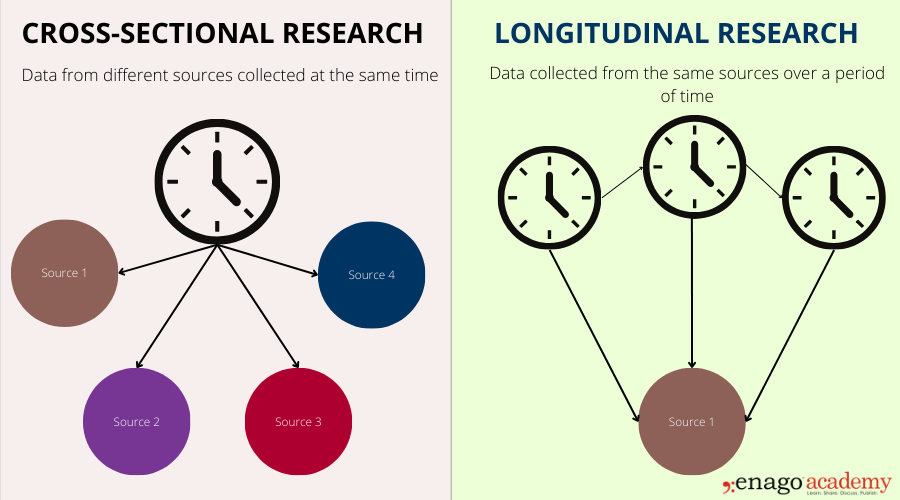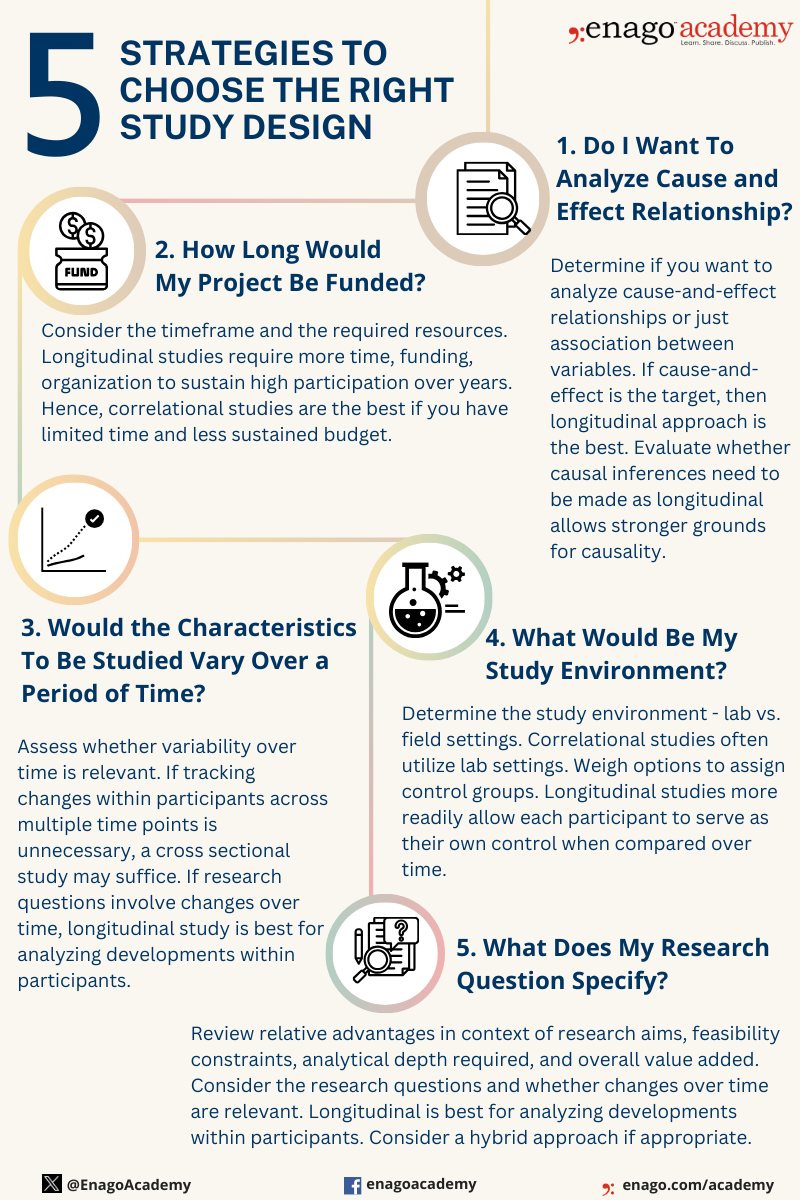Comparing Cross Sectional and Longitudinal Studies: 5 steps for choosing the right approach

The process of choosing the right research design can put ourselves at the crossroads of two distinct yet intertwined paths—cross-sectional and longitudinal studies. Selecting an appropriate study design is paramount in shaping the reliability of your investigation. Furthermore, a good study design not only influences the quality and validity of the study outcome but also ensures the alignment of the research question with the methodology.
What are Cross Sectional Studies and Longitudinal Studies
Picture this: the cross-sectional study as a photograph, freezing a moment in time to capture the details of a population and encapsulates the vibrancy of a singular moment. Now, contrast that with the cinematic nature of longitudinal studies, where the details unfold over time, and the suspense is revealed at the climax, after the story is shaped.

Both the study designs are different from each other are indispensable tools for conducting research. However, understanding the advantages and disadvantages of cross-sectional and longitudinal studies can help you in making an informed choice while selecting your study design.
Difference Between Cross Sectional and Longitudinal Studies
Cross-sectional studies and longitudinal studies are different in several ways. Here are some points of their differences:
|
|
Cross Sectional Studies |
Longitudinal Studies |
Definition |
Cross sectional study is an observational research in which the data is collected from different sources at the same time | Longitudinal studies is a type of research design in which data is gathered from the same subjects over an extended period of time |
Duration |
They are comparatively quicker as it is conducted at a single point of time | They span from a few years to decades as it requires revisiting the participants |
Causation Relationship |
Unable to establish cause-and-effect relationships | Likely to suggest cause-and-effect relationships |
Characteristics |
1. Takes place at a single point in time
2. Does not involve variable manipulation 3. Allows examination of multiple characteristics simultaneously |
1. Takes place over an extended period of time
2. Uses both quantitative and qualitative methods 3. Allows establishing a sequence in events or experiences |
Advantages |
1. Cross-sectional studies are often more efficient and cost-effective
2. Researchers can obtain results relatively quickly, making these studies suitable for research with a sense of urgency 3. The limited tracking of the subjects makes cross-sectional studies more resource-friendly 4. They can identify associations between variables and serve as a starting point to generate hypotheses for more in-depth investigations |
1. Longitudinal studies allows researchers to track changes over time
2. Researchers can study processes that unfold over extended periods, such as language development, effects of aging, etc. 3. Studying the same subjects over time serves each person as their own control 4. They can study rare phenomena and understand the developmental patterns and risk factors to better inform the creation of interventions and policies |
Limitations |
1. Doesn’t provide cause-and-effect relationships
2. May lack context about past or future events 3. May fail to capture the complexity of real life situations 4. The observed relationship could be temporary, situation-specific or changing over time 5. Researchers have less control and precision in measurement |
1. Risk of selection bias among participants
2. Expensive and Time-consuming 3. High chance of uncontrolled changes that may influence the outcomes 4. Requires sophisticated statistical analysis techniques to model the data and detect changes 5. Difficulty in keeping participants enrolled over many years |
Cost |
Cheap | Expensive |
Types |
Case-control studies, Ecological studies, Experimental Studies, and Cohort Studies | Panel studies, Retrospective studies, and Cohort Studies |
Subject Areas |
Economics, Developmental psychology, Medicine, Social science, Biology, Public health, Sociology | Psychology, Sociology, Medicine, Market Research, Political Science |
When Is It Used |
To describe the current state of a community and infer relationships for further research | To assess patterns of continuity or change in the characteristics within the same group |
Data Analysis |
Analyzes aggregate data to observe societal changes but lacks individual-level insights | Allows individual-level analysis, to understand changes over the study period |
Example |
Analyzing the diet and food choice across age groups in a retail store | Studying how diet affects weight by observing individuals over ten years |
Understanding the differences in the benefits and the components of these study designs can help researchers in choosing the right design for addressing their research question.
5 Steps to Choose the Right Research Design
Ask yourself these questions to make a right choice between a correlational or longitudinal research approach for your research:

The choice between a cross-sectional and longitudinal study depends on the research questions and objectives. Researchers may choose the study design based on the nature of their investigation, and sometimes a combination of both types may be employed for a comprehensive understanding of the subject matter.
Deciding between a cross-sectional or longitudinal design depends on the research question at hand. Are you a researcher still struggling to find the right research design to address your research question? Consider seeking assistance of professional services to ease your research planning journey and make informed decisions about study designs.
Frequently Asked Questions
A longitudinal study collects data from the same subjects repeatedly over an extended period of time. This allows studying changes over time at the individual level. A cross-sectional study collects data at one specific point in time and compares between groups or subgroups in a population rather than studying individuals over time. The key difference is that longitudinal studies track within-subject changes over time whereas cross-sectional studies provide a snapshot of between-group differences at a single time point.
Cross-sectional study is a type of observational research design in which data is collected from a population at a single point in time.
A longitudinal study is a research design in which data is gathered for the same subjects repeatedly over an extended period of time.
Cross-sectional studies are useful for estimating the prevalence of diseases, conditions, traits, attitudes, risk factors, or other health metrics in a population at a specific point in time. They provide snapshots of outcomes, exposures and their associations across an entire population or subgroups. This can inform interventions. Large recurring cross-sectional health surveys track health indicators, access to care and healthcare quality on a population basis. They may reveal patterns in the data at population level that can inform future longitudinal or experimental studies.
There is no single standardized duration for longitudinal studies. However, some general time frames of longitudinal studies are:
1. Short-term longitudinal studies - These track subjects for days, weeks, or months. For example, monitoring recovery from an illness daily for a few months.
2. Medium-term longitudinal studies – These follow subjects for 1 to 5 years, assessing change over this moderately long time period. For example, studying cognitive development from kindergarten to 4th grade.
3. Long-term longitudinal studies – These studies track subjects for many years or decades. Some examples are annual health surveys conducted over 20-30 years or studies on aging starting from early adulthood into late life.
4. Prospective longitudinal studies - These studies identify a sample and track them forward in time, rather than using retrospective records. They tend to be longer 10, 20 or 30+ year studies.
5. Panels - These survey the same group of subjects repeatedly at set intervals over an extended period.
Here are some situations where cross-sectional studies are most useful:
1. When wanting to estimate the prevalence of a condition/disease in a population for planning or resource allocation purposes. A cross-sectional health survey can achieve this.
2. When seeking to compare between subgroups defined by age, gender, ethnicity etc. at a given point in time rather than changes within groups over time.
3. When it is not practical or feasible to conduct long-term follow ups required in longitudinal studies due to costs, subject availability etc.
4. When retrospective data over time is not recorded or available, but gathering current snapshots is possible. For example comparing health metrics across different countries.
5. When the exposure and disease both happen quickly such that the sequence can be effectively captured in a cross-sectional assessment. For example - trauma and injuries.
6. When aiming to first explore or generate hypotheses about potential causal/contributing factors to screening for associations. These hypotheses can then feed into longitudinal analyses.




